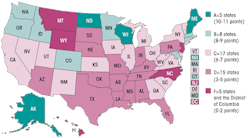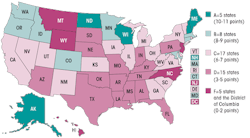In need of dental sealants?
by CHRISTINE NATHE, RDH, MS, RDH
Recently, the Pew Center on the States' Children's Dental Campaign released a report that focused on the states' efforts to improve the access that children from low-income families have to dental sealants. Pew reports have been presented in this column in the past, and many of them have focused on assessing dental public health services.
Broadly speaking, Pew provides nonpartisan reporting and research, advocacy, and technical assistance to help states deliver better results and achieve long-term fiscal health by investing in programs that provide strong returns. Specifically, the Pew Children's Dental Campaign studied dental issues to promote cost-effective policies to expand access to dental care and ensure millions more children receive the basic care they need to lead healthy lives.1
Consider reading:Advancing dental public health and dental hygiene research
Consider reading:A future leader for health-care integration
Consider reading: The U.S. isn't doing enough to prevent tooth decay, says Pew report
In 2010 and 2011, the Pew Children's Dental Campaign released reports grading all states on children's dental health. Pew used evidence-based policies that included prevention, financing, and workforce issues. This latest report focused on the sealants.
The Pew grades are based on four indicators of a state's dental sealant strategy. These include:
- Having sealant programs in high-need schools
- Allowing hygienists to place sealants in school-based programs without requiring a dentist's exam
- Collecting data regularly about the dental health of schoolchildren and submitting the data to a national oral health database
- Meeting a national health objective on sealants.
The significance of these indicators is that they focus on the delivery of preventive care in school settings. Ironically, this method of accessing schoolchildren was how the initial practice of dental hygiene began in Bridgeport, Conn., in the early 1900s. Equally important is the fact that an entire indicator focuses on dental hygienists applying sealants without a dentist's diagnosis. This definitely focuses on the ability of dental hygienists to make decisions for preventive care.
Interestingly, in 1921, Bridgeport's board of education voted to require a definite physical standard from every schoolchild, and after conferences with the Connecticut Department of Health, the board adopted resolutions that included dental standards. The resolution stated that all schoolchildren (a) [have] certification from the dental hygienist that there are no cavities in the permanent dentition, (b) demonstrate effectively the use of the toothbrush to remove food debris and keep the gums in a state of health, and (c) have teeth and gums that are in a clean and healthful condition.2
This implies that the practice of dental hygiene was created to assess dental health and diseases, and now that sealants are available, dental hygienists have the ability to assess for and prevent dental caries. Dental hygienists are the perfect dental providers to develop, manage, and operate programs that provide sealants to schoolchildren.
The report included this map of America, which depicts each state's grade in reference to dental sealants. The grades, which were determined on a scale of A to F, were based on the total points earned for all indicators.
Dental hygiene started with delivering oral health education to schoolchildren. It is motivating that Pew studied indicators that mirror dental hygiene's inception. Remembering and understanding our past can only help us when developing solutions for our future.
NOTE
1. Learn more about how each state performed in our state fact sheets at http://www.pewstates.org.
2. Fones AC. Mouth Hygiene. 3rd ed. Philadelphia, Pa: Lea & Febiger; 1927. RDH
CHRISTINE NATHE, RDH, MS, is a professor and director at the University of New Mexico, Division of Dental Hygiene, in Albuquerque, N.M. She is also the author of "Dental Public Health Research" (www.pearsonhighered.com/educator), which is in its third edition with Pearson. She can be reached at [email protected] or (505) 272-8147
Past RDH Issues

